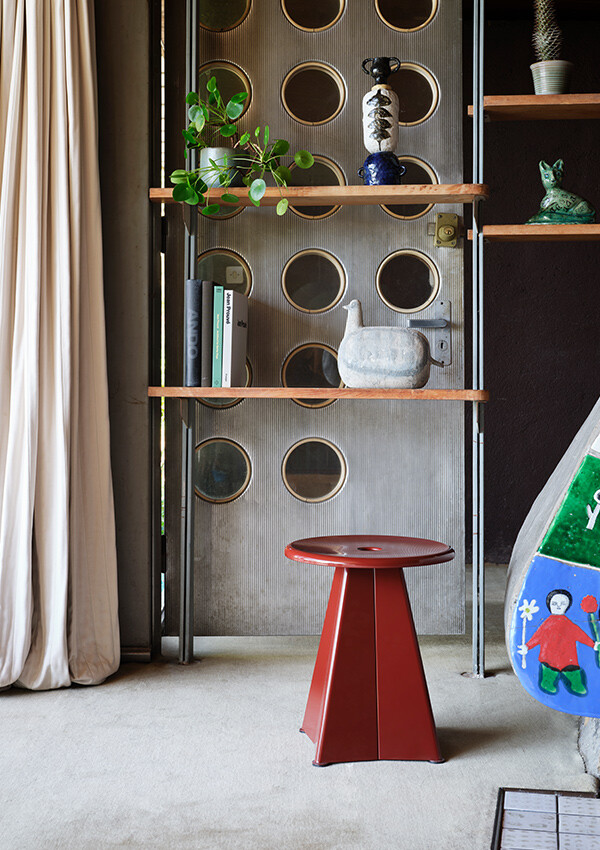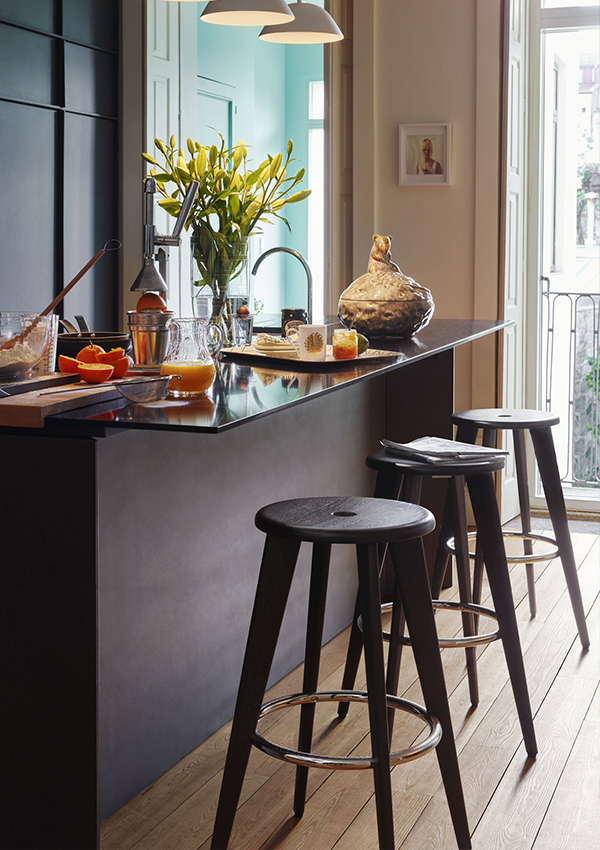Designers at Nest: Jean Prouvé
Self-taught architect, designer and designated ‘constructeur’, Jean Prouvé perfectly blended the worlds of architecture and engineering. Join us as we explore the varied career and multidisciplinary work of this iconic designer.
A designer with an unmistakable repertoire, the work of Jean Prouvé is instantly recognisable – guided by the goal of finding new and modern solutions to problems of construction and everyday life.
His style, capable of combining beauty and functionality, materials and shapes. Today, our E-commerce Website Editor Adam Batty shines a light on one of his favourite designers.
Jean Prouvé was born in Paris at the dawn of the Twentieth Century, an appropriate time and place for a man who blurred the lines between art and industry, given the metropolis's status as the City of Light and as an epicentre of creative thinking
Stemming from a creative family headed by a pianist mother and artist father, Prouvé's youth was one surrounded by the spirit of the l’École de Nancy, the art collective of which his father was a member. The Nancy School, as it was otherwise known, brought together a number of artisans, creatives and intellectuals concerned with the art nouveau movement. While Jean Prouvé's own work was a significant departure from the overly ornamental, lavishly decorated furniture of the art nouveau period, one can see echoes of this formative moment in there. While decoration, in a traditional sense, was not important to him, an aesthetic style certainly was. A keen sense of precision runs throughout Prouvé's body of work, which extends far beyond furniture and into architecture, infrastructure design and even academia. It was in Nancy where Prouvé's education would take place, first in fine art and then blacksmithing. The stark contrasts of these two pursuits would combine in the designer's unique approach to his craft, which stands at the crossroads of industrial production techniques and handmade craft.
The earliest examples of Prouvé’s furniture that are still in circulation today stem from the early 1930s and were produced through his organisation "Ateliers Jean Prouvé". The Standard Chair was first unveiled in 1934 and acts as the perfect showcase for the designer's aesthetic, with a machine-pressed metal frame finished with a wooden seat and seat back. An all-wood version was introduced in response to the metal shortages of the Second World War, while a plastic seat SP edition was later released. Still, the principle remains the same, with the legs taking a vast amount of pressure for the structure, giving the chair its unique silhouette, evident throughout the wider collection of seating and tables from this era. Objects such as the Tabouret stool and the Rayonnage Mural shelving system share the same trilateral angled supports and exhibit this beautiful blend of the machine and the organic, with the fusion of metal and wood used to a never-bettered effect.
Despite being heavily involved in the French Resistance effort, Prouvé would continue work throughout the Second World War, with his landmark Fauteuil range of lounge chairs reaching wide production in 1951. In amongst this range sits the Fauteuil Direction Pivotant, which stands as one of my favourite pieces from the designer's catalogue, with its unusual and instantly memorable combination of an industrial aesthetic with the highly functional needs of an office chair. The Cité armchair, from the same period, features a striking leather band that runs alongside the arms of the chair and underneath the base and is now rightly regarded as one of the era's most celebrated lounge chair designs.
In addition to creating iconic furniture such as the Table Solvay, the Lampe de Bureau and the Potence wall light, Prouvé was deeply politically minded and used his expertise to help in the post-war rebuilding of France. He worked as an architect, designing buildings and private residences, including a serially manufactured petrol station that took his unique brand of industrial design and applied it to a much grander scale. While prefabricated buildings would become more commonplace in the latter part of the 20th Century, Prouvé's approach in the early 1950s was genuinely ground-breaking and showed that he maintained that pioneering spirit some two decades into his career. I was lucky enough to visit one of the few remaining Prouvé petrol stations during a visit to Vitra's base in Weil am Rhein earlier this year.
Often collaborating with Le Corbusier and Charlotte Perriand, Prouvé is today remembered as one of the foremost designers of the 20th Century and one whose influence can be seen all around us. His innovative merging of art and technology, of design and mass production, would be foundational to the way furniture manufacturing would operate in the era, with his precise, dynamic designs capable of being reproduced in mass quantities remotely by the designer himself. Contemporary designers such as Virgil Abloh have cited Prouvé as a major influence, and collectors around the world eagerly seek out rare original examples of his work. Thanks to the tireless efforts of the Prouvé estate and partners such as Vitra, the enduring legacy of the designer who perfectly encapsulated the Modernist age of creativity lives on.
Designers at Nest: Jean Prouvé
Self-taught architect, designer and designated ‘constructeur’, Jean Prouvé perfectly blended the worlds of architecture and engineering. Join us as we explore the varied career and multidisciplinary work of this iconic designer.
A designer with an unmistakable repertoire, the work of Jean Prouvé is instantly recognisable – guided by the goal of finding new and modern solutions to problems of construction and everyday life.
His style, capable of combining beauty and functionality, materials and shapes. Today, our E-commerce Website Editor Adam Batty shines a light on one of his favourite designers.
Jean Prouvé was born in Paris at the dawn of the Twentieth Century, an appropriate time and place for a man who blurred the lines between art and industry, given the metropolis's status as the City of Light and as an epicentre of creative thinking
Stemming from a creative family headed by a pianist mother and artist father, Prouvé's youth was one surrounded by the spirit of the l’École de Nancy, the art collective of which his father was a member. The Nancy School, as it was otherwise known, brought together a number of artisans, creatives and intellectuals concerned with the art nouveau movement. While Jean Prouvé's own work was a significant departure from the overly ornamental, lavishly decorated furniture of the art nouveau period, one can see echoes of this formative moment in there. While decoration, in a traditional sense, was not important to him, an aesthetic style certainly was. A keen sense of precision runs throughout Prouvé's body of work, which extends far beyond furniture and into architecture, infrastructure design and even academia. It was in Nancy where Prouvé's education would take place, first in fine art and then blacksmithing. The stark contrasts of these two pursuits would combine in the designer's unique approach to his craft, which stands at the crossroads of industrial production techniques and handmade craft.
The earliest examples of Prouvé’s furniture that are still in circulation today stem from the early 1930s and were produced through his organisation "Ateliers Jean Prouvé". The Standard Chair was first unveiled in 1934 and acts as the perfect showcase for the designer's aesthetic, with a machine-pressed metal frame finished with a wooden seat and seat back. An all-wood version was introduced in response to the metal shortages of the Second World War, while a plastic seat SP edition was later released. Still, the principle remains the same, with the legs taking a vast amount of pressure for the structure, giving the chair its unique silhouette, evident throughout the wider collection of seating and tables from this era. Objects such as the Tabouret stool and the Rayonnage Mural shelving system share the same trilateral angled supports and exhibit this beautiful blend of the machine and the organic, with the fusion of metal and wood used to a never-bettered effect.
Despite being heavily involved in the French Resistance effort, Prouvé would continue work throughout the Second World War, with his landmark Fauteuil range of lounge chairs reaching wide production in 1951. In amongst this range sits the Fauteuil Direction Pivotant, which stands as one of my favourite pieces from the designer's catalogue, with its unusual and instantly memorable combination of an industrial aesthetic with the highly functional needs of an office chair. The Cité armchair, from the same period, features a striking leather band that runs alongside the arms of the chair and underneath the base and is now rightly regarded as one of the era's most celebrated lounge chair designs.
In addition to creating iconic furniture such as the Table Solvay, the Lampe de Bureau and the Potence wall light, Prouvé was deeply politically minded and used his expertise to help in the post-war rebuilding of France. He worked as an architect, designing buildings and private residences, including a serially manufactured petrol station that took his unique brand of industrial design and applied it to a much grander scale. While prefabricated buildings would become more commonplace in the latter part of the 20th Century, Prouvé's approach in the early 1950s was genuinely ground-breaking and showed that he maintained that pioneering spirit some two decades into his career. I was lucky enough to visit one of the few remaining Prouvé petrol stations during a visit to Vitra's base in Weil am Rhein earlier this year.
Often collaborating with Le Corbusier and Charlotte Perriand, Prouvé is today remembered as one of the foremost designers of the 20th Century and one whose influence can be seen all around us. His innovative merging of art and technology, of design and mass production, would be foundational to the way furniture manufacturing would operate in the era, with his precise, dynamic designs capable of being reproduced in mass quantities remotely by the designer himself. Contemporary designers such as Virgil Abloh have cited Prouvé as a major influence, and collectors around the world eagerly seek out rare original examples of his work. Thanks to the tireless efforts of the Prouvé estate and partners such as Vitra, the enduring legacy of the designer who perfectly encapsulated the Modernist age of creativity lives on.










